
|
|

January 25, 2008
WTMJ 620, Milwaukee
It's a new year here at Tower Site of the Week, and a new set of travel pictures to start us off. In August 2007, your editor and Mrs. Editor spent a few days traveling from her native Fort Wayne to Chicago, Milwaukee, Madison and then back to Fort Wayne via Rockford, Illinois, and along the way we had a chance to see some very significant broadcast sites.
One big goal of the trip was to pick up some loose ends from one of the more enjoyable stops we've made in recent years. Our 2005 Big Trip (featured here on Site of the Week in two installments, here and here, in 2006, and subsequently in a later piece for Radio World, where we used to have a column) included about a day and a half in Milwaukee, which was not nearly enough time to see all the broadcast history that the Brew City had to offer. And even though the main purpose of our Milwaukee stop this time wasn't radio-related, we still managed to work in a few of the sites we'd missed the last time out.
First, foremost and southernmost is this week's featured site: the six-tower facility of WTMJ (620 Milwaukee), erected in 1995 when the station left its longtime (1927!) tower site in Brookfield, west of Milwaukee and became one of the first regional-channel stations to increase power above the old 5 kW limit.
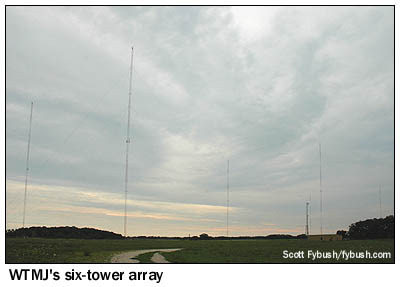
|
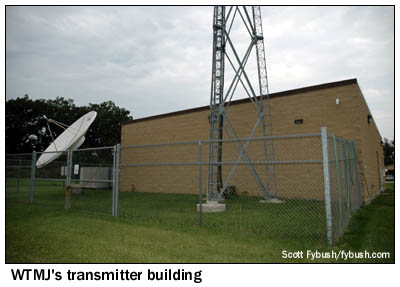 |
With the lifting of the old power restrictions, WTMJ was able to increase power to 50 kW by day and 10 kW by night - but it couldn't do so from the Brookfield site. Instead, it had to move south of Milwaukee, aiming most of its new power north, and that meant a new location some 20 miles south of downtown Milwaukee, just off US 45 near Union Grove in Racine County, Wisconsin.
Six 314' towers, broadly spaced, went up in what I believe is a cabbage field, with all six towers being used at night and four of the six being used by day. The combination of high power, a low dial position and a potent directional pattern gave the new WTMJ signal a reach all the way north to Green Bay with close to a city-grade signal day and night (a good thing for the flagship station of the Packers network!), and a pretty respectable signal west to Madison and south to the northern Chicago signals by day as well.
Inside the new building, there's plenty of space for everything this big AM signal needs: the big phasor for the day and night signals, the main Harris DX50, the backup DX10, and several racks of STL and processing gear, as well as separate rooms for an engineering office and a generator.
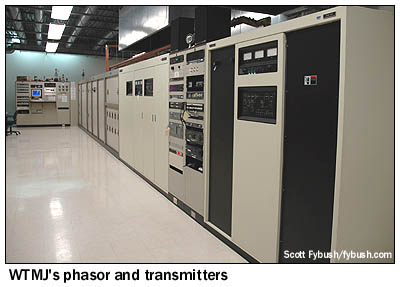
|
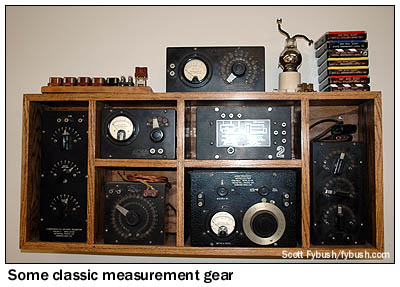
|
But WTMJ, with the attention it's always paid to its long history, decided to do something more with this new space than just install its relatively sterile new equipment. Over the years, its engineers have filled corners of the room (and the tops of several of the racks!) with artifacts from more than eight decades of WTMJ radio and television. There are classic microphones, not just the expected RCA 77s and 44s, but also some even more ancient examples. There's vintage measurement and test gear (most of what's in the rack shown above came from General Radio in Cambridge, Mass., probably in the thirties from the looks of it), old WTMJ-TV studio and field cameras, and even (not shown here) what may be one of the last intact editing setups for 2" videotape, which was edited by coating the tape with iron filings to make the magnetic patterns visible, then peering through a microscope to carefully cut the tape and reassemble it along frame lines. It still didn't work very well!
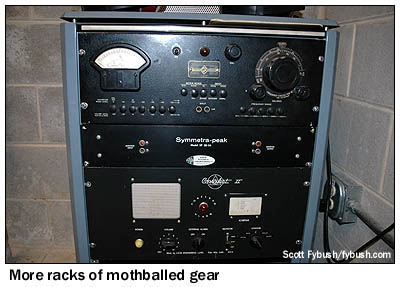 |
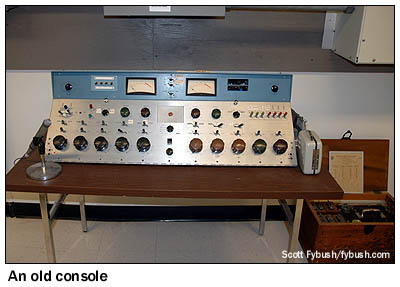
|
But wait - there's more! Additional vintage gear has been lovingly preserved in spare racks behind the transmitters and in other corners of the building. The rack shown above at left sits in the generator room, just in case someone needs to remember what a Kahn Symmetra-peak or a Kaar Conalert Conelrad box looked like. (WTMJ, it would appear, rotated its Conelrad signal with those of Milwaukee's WEMP and Chicago's WGN and WMAQ.)
There are scrapbooks showing the construction of this facility, preserving its history for future generations, and even a pristine console that I believe was once the main air board for WTMJ-FM on 94.5. (That wooden box next to it, which is about a generation older, is a General Radio "Type 224-L Precision Wavemeter."
Perhaps someday all of this gear will sit in a museum that's open to the public; for now, we're just thrilled to get our own little private look at it...and to look forward to another day of tower and studio visits, which we'll share with you next week. (And we're back to coordinating with our sister site, Wisconsin's own Tophour.com, where we'll have some new Milwaukee IDs posted on Wednesday for your listening pleasure...)
Tower Site Calendar 2008 is here! Visit the Fybush.com Store now and get your calendar now!
- Previous Site of the Week: WMVP (WCFL), Chicago
- Next Week: WXSS 103.7, WSSP 1250 and WMYX 99.1, Milwaukee
- Site of the Week INDEX!
- How can you help support Site of the Week? Click here!
- Submit your suggestions for a future Site of the Week!
